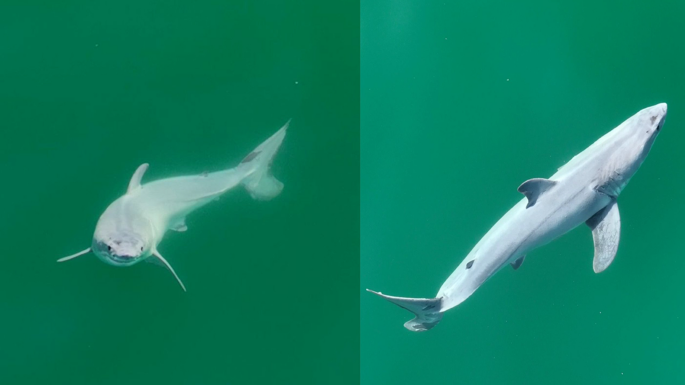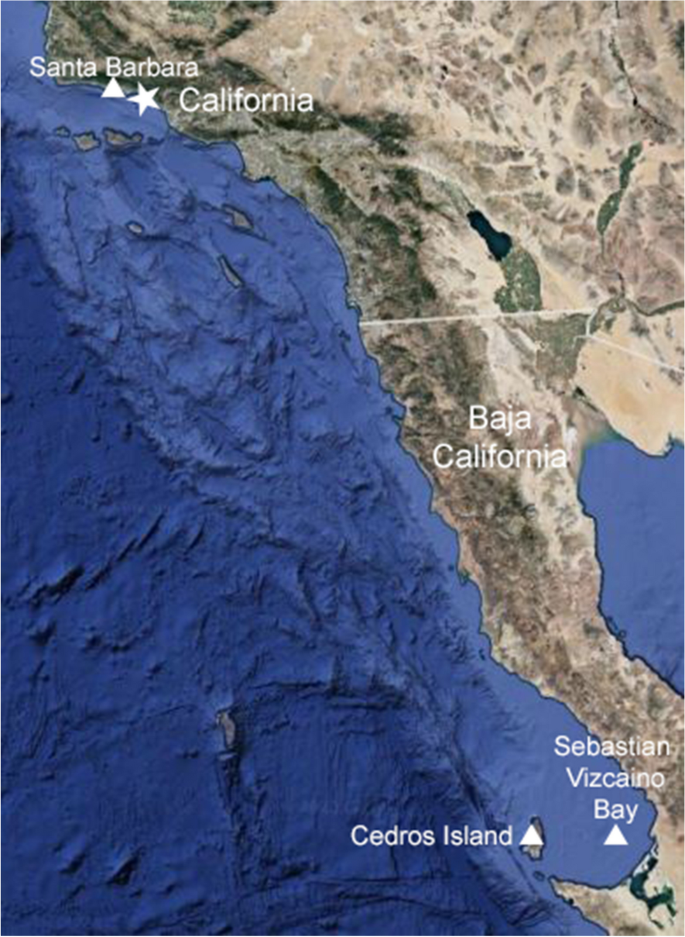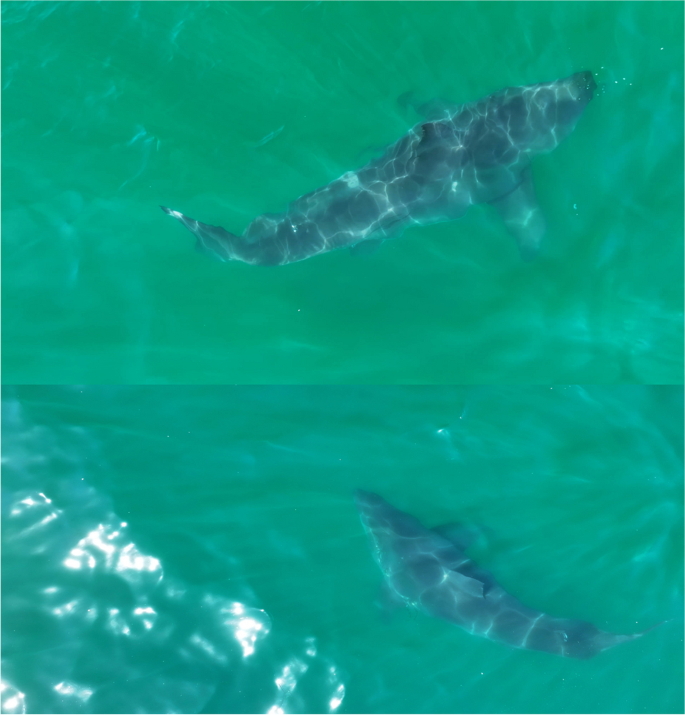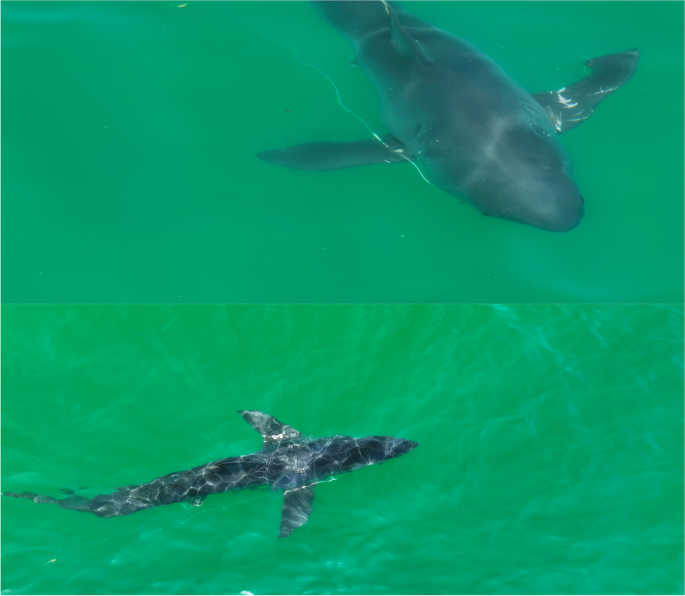Abstract
The white shark (Carcharodon carcharias) is the largest macropredatory fish in the world. Yet, there remains a paucity of data on the early life history and reproduction of this iconic shark. Here, we present aerial observations of an individual white shark that appears to be sloughing a white film from its body. We propose two possibilities for the possession of the white film: (1) this is a newly born white shark with intrauterine substances still adhered to its body, or (2) this white shark has an unknown skin disorder resulting in shedding, discharge, or possibly a microbial growth over the dermal layer. We discuss the possibility that this individual is a newborn and its implications for the Southern California region as a critical birthing location.
Avoid common mistakes on your manuscript.
The white shark (Carcharodon carcharias) is an iconic, large predatory shark with a worldwide distribution that attracts considerable interest from both the scientific community and the public (Klimley and Ainley 1996; Domeier 2012a; Huveneers et al. 2018; Ebert et al. 2021). Despite the high level of interest, there remain some major gaps in white shark life history such as information on breeding and newborns (Klimley 1985; Klimley and Ainley 1996; Domeier 2012a; Huveneers et al. 2018; Santana-Morales et al. 2020; Anderson et al. 2021). For example, Klimley (1985) suggested that large adult female sharks may use the area from Santa Barbara, California to north Baja California, Mexico to give birth. Recent evidence has supported this as Sebastian Vizcaino Bay (Orñate-González et al. 2017) and Cedros Island near Baja California, Mexico (Tamburin et al. 2020) as well as the coast of Southern California, USA (Anderson et al. 2021) had an abundance of young of the year white sharks that displayed high residency and restricted movements at these areas over the course of a year (Fig. 2). Furthermore, Santana-Morales et al. (2020) reported the smallest known free-living white shark was caught off the Pacific coast near the USA-Mexico international border, measuring 106.6 cm total length (TL) with morphological features similar to that of white shark embryos.
On July 9, 2023, a pale white shark (Fig. 1; Supplemental Video which is available by request/contact authors directly) was spotted via aerial drone (Mavic 3 Pro) 0.4 km off the coast of Carpinteria, CA, USA (Fig. 2). Upon close examination of video and photos, the individual’s pale color appears to be a thin white film covering the shark. We noted that as the shark was swimming, the whitish film was being sloughed off. During post-video analysis, we estimated the size of the individual to be 1.5 ± 0.2 m TL, although with some uncertainty (Supplementary Information). We also wish to point out that, both days prior and the day of, large likely mature sharks were also recorded in the same area (Fig. 3). We propose two possibilities for this shark’s interesting pale color: (1) the whitish film is left over intrauterine substances being sloughed off the shark due to it being a newborn shark, or (2) the whitish film is due to an unknown skin disorder that has not been reported in white sharks before in the published literature.
First, like other lamniform sharks, white sharks are viviparous, and embryonic sharks perform the unique behavior of oophagy (Gilmore 1993; Francis 1996; Uchida et al. 1996; Conrath and Musick 2012; Sato et al. 2016; Ebert et al. 2021). Oophagous sharks will consume eggs and store yolk in their stomachs as a source of nutrition (Gilmore 1993; Francis 1996; Uchida et al. 1996; Sato et al. 2016). In addition, pregnant female white sharks will also produce “uterine milk,” a yellowish and milky fluid, for the embryos to also consume (Sato et al. 2016). However, it remains unclear on the duration of this fluid being produced during the estimated 12-month gestation period (Sato et al. 2016). After the gestation period, an estimated 2–17 pups may be birthed (Ebert et al. 2021). In terms of morphology, the pups are very similar in appearance to near-term embryos as they are notable for being 1–1.6 m TL and with more rounded fin apexes (Francis 1996; Uchida et al. 1996; Tomita et al. 2018; Santana-Morales et al. 2020; Ebert et al. 2021). In the Northeast Pacific, Klimley (1985) proposed that from Santa Barbara to Baja California, during late summer and early fall, pregnant female white sharks would give birth to pups. Recent studies have supported this claim as vast amounts of young of the year white sharks have been tagged and monitored in this geographical range and time period (Orñate-González et al. 2017; White et al. 2019; Santana-Morales et al. 2020; Tamburin et al. 2020; Anderson et al. 2021).
Here, we offer one hypothetical scenario for this individual white shark and its whitish film. First, this individual white shark is an estimated 1.5 ± 0.2 m TL (Supplementary Information), well within the size range of newborn sharks (i.e., 1–1.6 m TL), and its overall appearance (i.e., rounded fin apexes) is similar to that of near-term embryos and the smallest reported free-living white shark (Francis 1996; Uchida et al. 1996; Tomita et al. 2018; Santana-Morales et al. 2020; Ebert et al. 2021). Second, this white shark was filmed in both the proposed area and specific time when pups are birthed (Klimley 1985). Third, large likely mature sharks were also recorded in the area with our drone surveillance (Fig. 3) and were also sighted by other researchers in the area (C. Lowe, personal communication). Taking these factors into consideration, a parsimonious interpretation is that the larger sharks may be mature females known to frequent this region (Klimley 1985) and that the pale subject is a newly born individual, possibly being days or even hours old. We propose that the whitish film being sloughed off the body is composed of intrauterine substances that had adhered to the shark while still in its mother’s uterus. Given that white sharks produce “uterine milk,” it is within the realm of possibility either this fluid or another fluid could have adhered to the shark right before birth.
In the alternative scenario, this individual white shark has a unique unknown skin disorder. Skin disorders are known to occur in sharks and rays, but it is rare (Gervais et al. 2016; Rodrigues et al. 2023). For example, albinism and leucism have been reported in only 62 (including one reported case of albinism in the white shark) of the 1200 species of elasmobranchs (Smale and Heemstra 1997; Bigman et al. 2016; Arronte et al. 2022; Becker et al. 2023; Rodrigues et al. 2023). It has also been noted that pollution and temperature may affect normal pigmentation development leading to irregular color patterns (Gervais et al. 2016; Bruckner and Coward 2018). However, the evident sloughing of a semi-opaque layer from the small shark reveals normal pigmentation below; therefore, albinism and leucism are not supported (Fig. 1; Supplemental Video which is available by request/contact authors directly). Skin diseases such as dermatitis and other bacterial infections have been reported in sharks (Leibovitz and Lebouitz 1985; Garner 2013; Pogoreutz et al. 2019; Newton and Ritchie 2022), but none of these reported conditions are similar to the one observed in this individual white shark. Therefore, this may be an unknown skin disorder that has not been reported in the literature before.
Here, we have presented evidence of an individual white shark with a whitish film covering its body, observed off the coast of Southern California. We propose two explanations for this individual’s white milky appearance: the first being it is a newborn shark with embryonic substance forming a layer on the shark and the second being the shark has an unknown skin disorder. For the first proposal, previous studies have demonstrated that this region of Southern California, USA, is a critical nursery habitat for white sharks in the Eastern Pacific (Klimley 1985; Domeier 2012b; White et al. 2019; Anderson et al. 2021). If this is indeed a newborn individual, this demonstrates the critical importance of this area in Southern California to Eastern Pacific white sharks. White sharks are highly protected off California (Heneman and Glazer 1996), but incidental catches by fishermen do occur (Lowe et al. 2012; Benson et al. 2018). Although individuals are released, some may retain hooks and fishing leaders that cause stress, damage, and possible subsequent death to the individuals (Fig. 4; Lowe et al. 2012; Benson et al. 2018). Therefore, more effort and stricter management might be required to protect not only this area but the entire coastline extending down to Baja California as well for white shark conservation. In terms of the second proposal, this would represent a previously unknown skin disorder that has not been observed in white sharks or sharks and rays in general. Both hypotheses will require further investigation and additional evidence for support or refutation. Nevertheless, in either case, the use of the aerial drone has provided shark science with another interesting set of information (Butcher et al. 2021). Therefore, future drone observations of sharks in this area will greatly improve our knowledge and understanding of white shark life history.
Data availability
Data is available upon request.
References
Anderson JM, Burns ES, Meese EN, Farrugia TJ, Stirling BS, White CF, Logan RK, O’Sullivan JO, Winkler C, Lowe CG (2021) Interannual nearshore habitat use of young of the year white sharks off Southern California. Front Mar Sci 8:64512
Arronte JC, Antolínez A, Bañon R, Rodríguez-Gutiérrez J, Ortíz JJ, Martinez JM (2022) First recorded case of leucism in the velvet belly lantern shark Etmopterus spinax (Squaliformes: Etmopteridae). J Appl Ichthyol 38:455–461
Becker MA, Kline CG, Maisch HM IV, Sternes PC, Shimada K (2023) First-hand observations of rare piebaldism in the nurse shark, Ginglymostoma cirratum, near East Bahia Honda, Florida Keys, Florida. Florida Scientist 86:13–16
Benson JF, Jorgensen SJ, O’Sullivan JB, Winkler C, White CF, Garcia-Rodgriguez E, Sosa-Nishizaki O, Lowe CG (2018) Juvenile survival, competing risks, and spatial variation in mortality risk of a marine apex predator. J Appl Ecol 55:2888–2897
Bigman JS, Knuckley JDS, Ebert DA (2016) Color aberrations in chondrichthyan fishes: first records in the genus Bathyraja (Chondrichthyes: Rajiformes: Arhynchobatidae). Mar Biodivers 46:579–587
Bruckner AW, Coward G (2018) Unusual occurrence of abnormal skin pigmentation in blacktip reef sharks (Carcharhinus melanopterus). Coral Reefs 37:389
Butcher PA, Colefax AP, Gorkin RA, Kajiura SM, Lόpez NA, Mourier J, Purcell CR, Skomal GB, Tucker JP, Walsh AJ, Williamson JE, Raoult V (2021) The drone revolution of shark science: a review. Drones 5:8
Conrath CL, Musick JA (2012) Reproductive biology of elasmobranchs. In: Carrier JC, Musick JA, Heithaus MR (eds) Biology of sharks and their relatives, second edn. CRC Press, Boca Raton, pp 291–311
Domeier ML (2012a) Global perspectives on the biology and life history of the white shark. CRC Press, Boca Raton
Domeier ML (2012b) A new life-history hypothesis for white sharks, Carcharodon carcharias, in the Northeastern Pacific. In: Domeier ML (ed) Global perspectives on the biology and life history of the white shark. CRC Press, Boca Raton, pp 199–224
Ebert DA, Dando M, Fowler S (2021) Sharks of the world: a complete guide. Princeton University Press, Princeton
Francis MP (1996) Observations on a pregnant white with a review of reproductive biology. In: Klimley AP, Ainley DG (eds) Great white sharks: the biology of Carcharodon carcharias. Academic Press, San Diego, pp 157–172
Garner MM (2013) A retrospective study of disease in elasmobranchs. Vet Pathol 50:377–389
Gervais C, Mourier J, Rummer J (2016) Developing in warm water: irregular colouration and patterns of a neonate elasmobranch. Mar Biodiversity 4:743–744
Gilmore RG (1993) Reproductive biology of lamnoid sharks. Environ Biol Fishes 38:95–114
Heneman B, Glazer M (1996) More rare than dangerous: a case study of the white shark conservation in California. In: Klimley AP, Ainley DG (eds) Great white sharks: the biology of Carcharodon carcharias. Academic Press, San Diego, pp 481–491
Huveneers C, Apps K, Becerril-García EE et al (2018) Future research directions on the “elusive” white shark. Front Mar Sci 5:455
Klimley AP (1985) Areal distribution and autoecology of the white shark off the western coast of North America. Mem Calif Acad Sci 9:15–40
Klimley AP, Ainley DG (1996) Great white sharks: the biology of Carcharodon carcharias. Academic Press, San Diego
Leibovitz L, Lebouitz SS (1985) A viral dermatitis of the smooth dogfish sharks, Mustelus canis (Mitchell). J Fish Dis 8:273–279
Lowe CG, Blasius ME, Jarvis ET, Mason TJ, Goodmanlowe GD, O’Sullivan JB (2012) Historic fishery interactions with white sharks in the Southern California Bight. In: Domeier ML (ed) Global perspectives on the biology and life history of the white shark. CRC Press, Boca Raton, pp 169–185
Newton AL, Ritchie KB (2022) Elasmobranch health, pathology, and the host microbiome. In: Carrier JC, Simpfendorfer CA, Heithaus MR, Yopak KE (eds) Biology of sharks and their relatives, third edn. CRC Press, Boca Raton, pp 421–485
Orñate-González EC, Sosa-Nishizaki O, Herzka SZ, Lowe CG, Lyons K, Santana-Morales O, Sepulveda C, Guerrero-Avila C, García-Rodríguez E, O’Sullivan JB (2017) Importance of Bahia Sebasatian Vizcaino as a nursery area for white sharks (Carcharodon carcharias) in the Northeastern Pacific: a fishery dependent analysis. Fish Res 188:125–137
Pogoreutz C, Gore MA, Perna G, Millar C, Nestler R, Ormond RF, Clarke CR, Voolstra CR (2019) Similar bacterial communities on healthy and injured skin of black tip reef sharks. Anim Microbiome 1:9
Rodrigues A, Shkola W, Ranel BS (2023) Extending records of albinism and skin disorders in American cownose rays to southeastern Brazil. J Fish Biol 103:453–456
Santana-Morales O, Abadía-Cardoso A, Hoyos-Padilla M, Naylor GJP, Corrgian S, Malpica-Cruz L, Aquino-Baleytό M, Beas-Luna R, Sepulveda CA, Castillo-Géniz JL (2020) The smallest known free-living white shark Carcharodon carcharias (Lamniformes: Lamnidae): ecological and management implications. Copeia 108:39–46
Sato K, Nakumura M, Tomita T, Toda M, Miyamot J, Nozu R (2016) How great white sharks nourish their embryos to a large size: evidence of lipid histrotrophy lamnoid shark reproduction. Biol Open 5:1211–1215
Smale MJ, Heemstra PC (1997) First record of albinism in the great white shark, Carcharodon carcharias (Linnaeus, 1758). S Afr J Sci 93:243–245
Tamburin E, Hoyos-Padilla M, Sánchez-González A, Hernández-Herrera A, Elorriaga-Verplancken FR, Galván-Magaña F (2020) New nursery area for white sharks (Carcharodon carcharias) in the Eastern Pacific Ocean. Turk J Fish Aquat Sci 20:325–329
Tomita T, Toda M, Miyamoto K, Oka S, Ueada K, Sato K (2018) Development of the lunate-shaped caudal fin in white shark embryos. Anat Rec 301:1068–1073
Uchida S, Toda M, Teshima K, Yano K (1996) Pregnant white sharks and full-term embryos from Japan. In: Klimley AP, Ainley DG (eds) Great white sharks: the biology of Carcharodon carcharias. Academic Press, San Diego, pp 139–155
White CF, Lyons K, Jorgensen SJ, O’Sullivan J, Winkler C, Weng KC, Lowe CG (2019) Quantifying habitat selection and variability in habitat suitability for juvenile white sharks. PLoS ONE 14:e0214642
Acknowledgements
We deeply thank J. Worthington (UCSD) for their help in estimating the size of sharks. We also thank A. Shultz (LACM) for providing useful information on pelican size ranges. Lastly, we thank the four anonymous reviewers and the editor for their comments and suggestions that greatly improved the quality of this paper.
Author information
Authors and Affiliations
Contributions
CG flew the drone and collected video and pictures of the sharks. CG and PCS both analyzed video and pictures of the sharks. PCS wrote the manuscript. CG and PCS reviewed and edited the text.
Corresponding author
Ethics declarations
Ethics approval
Sharks were viewed by drone requiring no protocol approval.
Consent to participate
All authors agreed to participate.
Competing interests
The authors declare no competing interests.
Additional information
Publisher’s note
Springer Nature remains neutral with regard to jurisdictional claims in published maps and institutional affiliations.
Supplementary Information
Below is the link to the electronic supplementary material.
Below is the link to the electronic supplementary material.
Rights and permissions
Open Access This article is licensed under a Creative Commons Attribution 4.0 International License, which permits use, sharing, adaptation, distribution and reproduction in any medium or format, as long as you give appropriate credit to the original author(s) and the source, provide a link to the Creative Commons licence, and indicate if changes were made. The images or other third party material in this article are included in the article's Creative Commons licence, unless indicated otherwise in a credit line to the material. If material is not included in the article's Creative Commons licence and your intended use is not permitted by statutory regulation or exceeds the permitted use, you will need to obtain permission directly from the copyright holder. To view a copy of this licence, visit http://creativecommons.org/licenses/by/4.0/.
About this article
Cite this article
Gauna, C., Sternes, P.C. Novel aerial observations of a possible newborn white shark (Carcharodon carcharias) in Southern California. Environ Biol Fish 107, 249–254 (2024). https://doi.org/10.1007/s10641-024-01512-7
Received:
Accepted:
Published:
Issue Date:
DOI: https://doi.org/10.1007/s10641-024-01512-7





